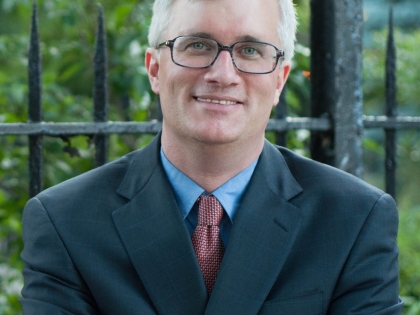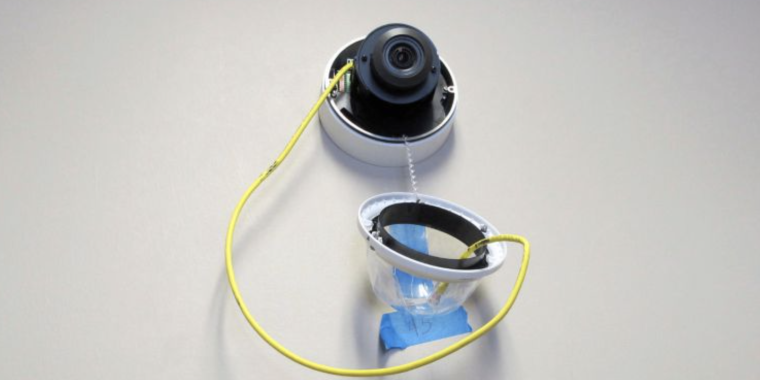
Newsday: Albany Starting to Grapple with Facial Recognition Technology

A camera with facial recognition capabilities hangs from a wall while being installed in Lockport (NY) High School in July of 2018. Credit: AP/Carolyn Thompson
On September 9, 2019, Yancey Roy of Newsday published a story about legislation (S5140B/A6787D) introduced by Senator Kavanagh and Assemblymember Monica Wallace to place a moratorium on schools' use of facial recognition technology. The full text is below; the original version is available via the link above.
_______________
Albany Starting to Grapple with Facial Recognition Technology
By Yancey Roy
September 9, 2019
ALBANY — A western New York school district’s bid to become the first to install facial recognition technology in its building hallways has sparked a state review and calls to either place a moratorium on such technology or ban it outright.
It’s the latest installment of the growing battle over facial recognition technology in Albany — a clash occurring in cities, towns and state legislatures around the nation as the surveillance machinery develops.
“Privacy, data protection and surveillance, in all its forms, are issues the state needs to take up,” said Sen. Brian Kavanagh (D-Manhattan), co-sponsor of a bill to put a moratorium on schools’ use of the technology. “It’s long overdue.”
The use of facial recognition technology isn’t new in New York. For example, the state Department of Motor Vehicles has been using it for nearly a decade to stop identity theft and keep disqualified drivers from obtaining licenses, it says. A significant technology upgrade in 2016 has triggered thousands of arrests, the agency said.
But the use of facial recognition technology in two other venues — apartment buildings in New York City and schools in Lockport in Niagara County — has opened up debate in a way previously not seen in Albany.
Legislators have proposed bills to bar the use of facial recognition technology on all rental properties and by drones, to block any state agencies or contractors doing business with the state from using the technology, to create a state task force on the issue and compel the state Education Department to study it, and, if the technology is approved, issue usage guidelines to schools.
The latter stems from Lockport’s bid to use facial recognition technology in its school hallways. It bought and installed the equipment in 2018 and sought to activate it in the 2019-20 school year.
In March, Kavanaugh and Assemb. Monica Wallace (D-Lancaster) introduced a bill seeking an immediate moratorium and calling on the Education Department to study the issue.
“I think people weren’t even aware it was an issue,” Wallace said of her legislative colleagues’ reaction when she submitted the bill. “Once they became aware, there was almost a universal reaction that we should study this … and, at minimum, we should have universal guidelines.”
Wallace said as news coverage grew of Lockport’s proposal, she began getting more emails from constituents and school parents.
“They did not realize this was something schools were trying to do,” she said.
Wallace said the technology raised many concerns about whose images would go into a local database, who controls storage and possession of the images, and how to protect — or if it’s possible to protect — against the hacking, phishing and selling of student data. Others have raised the accuracy issue, saying the technology has problems identifying women, people of color and young people.
Plus, the notion of having cameras in every school hallway, recording everyone’s activity, “seems a little Big Brother-ish to me,” she said.
The Assembly in June approved the moratorium bill, 128-19. But the legislative session adjourned before the Senate could act. Kavanagh said it simply ran out of time in what proved to be a busy session.
Meanwhile, the Education Department in June told Lockport not to proceed, pending a review.
Lockport officials revised their proposal in August — changing it from maintaining a database of all students and personnel to a pared-down list of people deemed dangerous, sex offenders and some others, according to media reports. The school district submitted the new proposal to the Education Department.
“We believe it does provide another layer of security for our students. We firmly believe in that," John Linderman, Lockport’s school board president, told the Buffalo News.
The Education Department is reviewing the latest iteration, a spokeswoman said, and again told the district it “should refrain from the use of the facial recognition technology until proper protocols and protections are in place.”
Kavanagh said state lawmakers are “likely to take action if the state Education Department can’t prevent this technology from being used as proposed.”
The proposal to ban the technology from apartment buildings was spurred by the news that developers in parts of New York City were seeking to install facial recognition as an alternative to key or pass code systems. Legislators called it "troubling" because it could lead to spying and studies show the software has trouble identifying faces of people of color.
"Facial recognition systems would give landlords the ability to track, at the very least, every entry and exit of their tenants and guests," Sen. Brad Hoylman (D-Manhattan) wrote in a memo submitted with the bill. "The potential for misuse of this information by landlords is high, particularly those looking to intimidate or drive out longtime tenants of rent-regulated housing."
Neither house acted on the bill in the 2019 legislative session.
About a dozen states have proposed or enacted laws to limit use of the technology, according to the Washington-based Project on Government Oversight. San Francisco and Oakland, the hub area of the tech boom, are among the first cities to ban its government agencies from using it.
The New York Civil Liberties Union said it believes Lockport is the lone school district in the country “trying to use this technology on children.”
“Schools are trying to do what’s best for kids, but this is not it,” said Stefanie Coyle, a policy lawyer with the NYCLU. “Schools want to be safe and want to do something. But that leads them to embracing some tactics that are not well thought out.”
###
